FISHING IN NORWAY
Gaula River Beats |
|
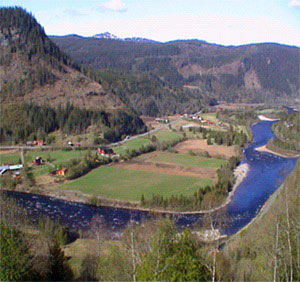 Basic
Information Basic
Information
The Gaula River is located in the southern part of
Central Norway - the region to the north, east, and
south and west of the city of Trondheim, which
celebrated its millennium in 1997. During its early
years it was The Viking capital of Scandinavia. The
area is often claimed to be the ‘heart of Norway’.
The contrasts of the region are
impressive - from the open coast to the mountains,
with high plains and snowy peaks. Fir and pine
covered hillsides leading to the rolling fields and
well-tended farms with impressive farm buildings.
The area has a past that has made its mark on the
history of Norway from the Viking age until today.
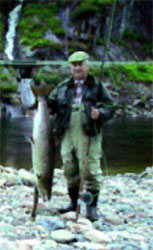 The
River The
River
The Gaula has over the
years consistently, together with Tana, Namsen and
Orkla, been among Norway’s top two to three Salmon
Rivers measured in overall catch and weight (in
Norway normally measured in metric tonnes). During
the last seasons the Gaula has produced a credible
35 – 50, representing around 8.000 - 12.000 rod
caught salmon with an average of around 4kg (near
9lb).
Angling, as we know it, started on
the Gaula around 1820 when English fishermen
discovered the riches of the river. The Gaula became
very popular among English noblemen and rumours of
record high salmon catches and sizes brought
significant numbers of Englishmen to fish the Gaula
during the summer months. Several built summer homes
in the Gaula valley, and the English saw the river
as their own for almost a century. This period of
salmon fishing brought a lot of wealth to the local
farmers and communities and a number of the farms
today are noticeably influenced by this English
period
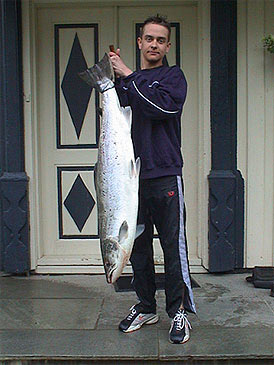 The
fishing The
fishing
The Gaula is well known
for its big salmon. Throughout the season there is
always the chance to catch the big one and the
biggest salmon start their run in early June. Every
year there are a number of fish caught that weigh
between 18 and 20 kilograms (40–45 lb).
The Gaula has a total length of
200 kilometres (125 miles) with catchment areas of
3,650 square kilometres. The salmon run of the main
river is 110 kilometres (55 miles) and in addition
there are good salmon runs in the main tributaries.
The Gaula benefits from a reasonably stable flow of
water throughout the season particularly when the
winter conditions have provided plenty of snow in
the catchment area. Rain showers during late July
and August help to keep the river in optimal
condition.
Due to its length and diversity,
the Gaula offers a wide variety of exciting angling
and a number of stretches offer the best fly-fishing
for salmon anywhere in the world.
The Malum/Winsnes beat offers
nearly 2 miles double bank fishing, some 20
kilometres up river from the village of Støren and
approx. 70 kilometres from the sea. The whole beat
is divided into three zones of approx. 750 metres
each and this provides 4 rods exclusive fishing on
each zone. A good number of pools in each zone
provide excellent chances of catching salmon for
both the experienced and the novice angler.
Normally, two anglers will be placed together on
each side of the available zone and a rotating
system is in place.
The Malum/Winsnes beat on the
Gaula River is one of the best salmon fishing offers
in Norway. The annual catches throughout the season
is in the region of 200 salmon, average weights
around 4.5 kg (10 lb). The atmosphere of the place
and the hospitality and friendliness by the farm
owners and friends are second to none. I rate the
whole set up at the Malum/Winsnes Farm very highly.
A true **** place to spend a week fishing!
Target Species
- Atlantic Salmon
- Char
- Sea Trout
- Brown Trout
Best Time of
Year
The Winsnes Farm offers
fishing from June 1st till August 31st. Normal
changeover day is Monday. We are offering a number
of weeks fishing with 4 rods per week. See enclosed
table.
The fishing is good throughout the
season
Tackle
Required
16ft rod 10-12 weight lines shooting
heads required also 12lb-15lb point is a must along
with vaeiwd mix of lines for sink to intermediate
and sink.
Country
Location
Map of river and beat at the
Malum/Winsnes beat.
Your fishing will primarily be the Zone 1 (Sone 1)
but possibility of rotating with Zone 2 but this is
not clarified yet. Zone 1 is approx. 800 meter
double bank fishing.
Red letters A and B indicates the two islands that
can be fished from both sides.
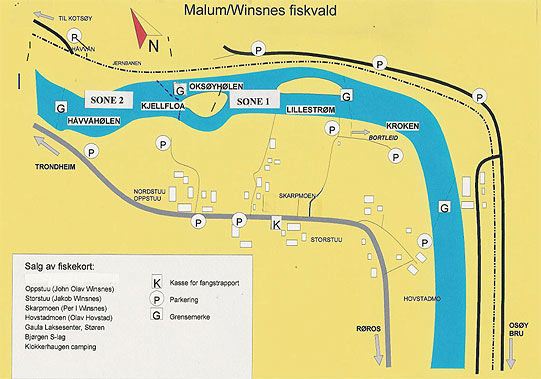
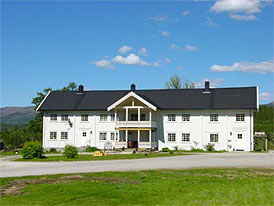 Travel
Arrangements and Accommodation. Travel
Arrangements and Accommodation.
The long and narrow main house (lån) is
typical of the regional architecture (Tröndelag).
From approx. 1890 to 1910 the house was used for
English lords who were fishing the Gaula. A number
of pictures, coupes and other paraphernalia can
still be seen from this period. The house dates from
1882 and has been extended and modernised to reflect
growing family demands. The ground floor of the
house has one big kitchen, 2 spacious dining areas
and additional lounges. All bedrooms are on the
first floor with beds for up to 12 people. There are
double-bed arrangements in two large bedrooms. There
is 1 toilet on ground floor and 2 toilets, showers
and bathroom on the first floor.
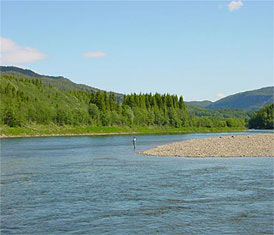 Guests
will be looked after well. The Tröndelag region has
a high reputation for hospitality and friendliness
towards visitors and Winsnes is no exception. You
will find the atmosphere relaxed and informal. Two
to three wholesome meals will be provided each day
using produce from local farms and the area.
Reindeer and moose meet may be on the menu.
Afternoon tea surprises from the family chef are not
unusual - her 'lefse' and waffles are a treat for
any tired fisherman. Guests
will be looked after well. The Tröndelag region has
a high reputation for hospitality and friendliness
towards visitors and Winsnes is no exception. You
will find the atmosphere relaxed and informal. Two
to three wholesome meals will be provided each day
using produce from local farms and the area.
Reindeer and moose meet may be on the menu.
Afternoon tea surprises from the family chef are not
unusual - her 'lefse' and waffles are a treat for
any tired fisherman.
Travel from the UK via Oslo
Airport. The flying time from London Heathrow to
Oslo Airport is around 1-hour 5o minutes and the
domestic flight between Oslo Airport and Trondheim
Airport is approx. 45 minutes. If flying with
Scandinavian Airlines, big and modern aircrafts are
being used.
Car hire is the most common way of
transport from the airport to the Winsnes Farm, a
driving time of around 1 hour 30 minutes is normal.
Attractions
Röros (A UNESCO’s World Heritage
listed town)
Located on a mountainous site, its history is linked
to the exploitation of copper mines, discovered in
the 16th century and used for 333 years until 1977.
Completely rebuilt after its destruction by Swedish
troops in 1679, the town includes some eighty wooden
houses, most of which are grouped around courtyards.
Many of them still retain their dark pitch log
façades that give the town a medieval aspect. The
church tower is a very famous landmark.
Cost of Holiday
and Duration
One week fishing in June
incl. light guiding, 7 night accommodation with
full board arrangements, flights from London
Heathrow to Trondheim Airport, hire car or local
transport from airport and return, mandatory
Government licence, disinfections of equipment will
cost a total of £ 2.395 per person
|

